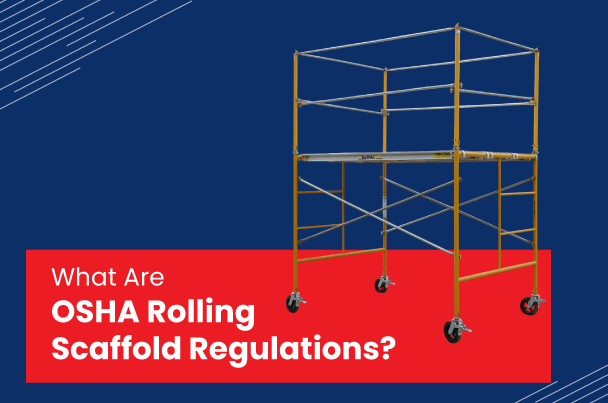
When you observe a construction site closely, you will come across scaffolding. This temporary structure enables workers to carry out tasks at extreme heights. But, when workers have to change their positions, they use a rolling scaffold. But, are you familiar with the OSHA rolling scaffold regulations? Well, if that isn’t the case, then here is an article to go through. In this article, we have covered more about the regulations and why it’s essential to stay compliant.
What are rolling scaffolds?
Rolling scaffolds are nothing but mobile scaffolds that are supported on a set of wheels. So, these scaffolds can be moved across the site with minimal effort. Most of the time, the scaffolds are useful when workers have to change their positions often. They are usually used when workers have to paint or apply plaster on different walls. Moreover, single bay scaffold towers are the most common types of rolling scaffolds. But, when you visit a site, you may also come across narrow frame scaffolds. Apart from everything else, people prefer using rolling scaffolds because they are better than ladders. They can also be installed with ease even when the surface is uneven.
Key OSHA Rolling Scaffold Regulations
Since rolling scaffolds are mobile, many safety standards have to be met. Organizations also have to inform workers to use the mobile scaffold safely. But, before using the scaffold, experts need to conduct an inspection. In those instances, the professionals must remove damaged parts and replace them immediately. In case this tip is overlooked, then you may never know when workers may get injured. Now, let’s check out the various OSHA regulations.
- When workers have to use the scaffold, they need to follow a certain approach. Besides, when it’s time to climb onto the scaffold, they must also ensure that the castor brakes are locked. A method also needs to be followed while descending the scaffold.
- Before erecting a rolling scaffold, workers have to follow the instructions while assembling it. But, you must impart training to the workers so that they can erect the temporary structure carefully. Once erected, workers must also check whether the wheels can be locked to mitigate rolling.
- As and when the scaffold has to be moved, workers have to ensure that the location is not cluttered. In such a case, they have to keep material and equipment away from the scaffold. But, before setting up the scaffold, they need to ensure that there are no obstructions on the surface. This is one of the most important OSHA rolling scaffold regulations.
- At the time of inspections, rolling scaffolds have to be thoroughly checked for safety. Workers must check for broken components and issues pertaining to stability. Additionally, they must not forget to check the locking mechanism. In case significant alterations are made, then the scaffold has to be inspected once again.
- For overhead protection, workers must always use personal protective equipment (PPE). They further must ensure that there are no falling objects in the vicinity. This can prevent the occurrences of hazards when they are using the rolling scaffold.
- Among the OSHA rolling scaffold regulations, the height-to-base ratio for a rolling scaffold must be a maximum of 4:1. This means that for every 4 feet of height, the base must be a minimum of 1 foot wide. If this ratio exceeds, then the workers must use braces. These will offer additional support and prevent them from falling.
- Planks must also be placed properly across the rolling scaffold’s platform. During installation, workers must also ensure that there are no gaps more than 1 inch between the frames. In addition, the height meant for carrying out tasks must also not exceed 125 feet. However, this height can vary depending on the scaffold type.
- Guardrails need to be set up if the rolling scaffold is 10 feet or more in height. Besides, the top rail height must be 42 inches with a tolerance of 3 inches.
Why Compliance with OSHA Rolling Scaffold Regulations Matters?
When you ensure compliance with OSHA rolling scaffold regulations, it ensures legal responsibility. In addition, workers can also use the scaffold safely while carrying out different tasks. Let’s now check why it’s essential to follow OSHA regulations.
Safety for the workers
As rolling scaffolds are used for different levels, workers are likely to fall. But, once the regulations, like the need for guardrails, are followed, it will certainly prevent accidents. The risk of falling can also be mitigated when the platform is developed properly.
Legal Compliance
Complying with OSHA standards can keep you away from bearing penalties and fines. In case of an accident that occurs unexpectedly due to non-compliance, then the company would be known for negligence. Moreover, there are less risks of costly disputes when someone is injured.
Promotes safe use and motion
By complying with motion-related regulations, the team can avoid getting caught in unexpected incidents. This can further lead to less delays in project execution. Individuals also don’t have to bother about anything when the scaffold stays stationary.
Enhances Trust and Morale
When workers observe the contractor following safety regulations, they will feel more confident. This will further enhance morale and develop an optimistic work culture. Ensuring compliance can further help maintain a good relationship with the worker’s representatives.
Prevents the likelihood of damage
As OSHA regulations ensure that the scaffold is set up in the right way, it can reduce the risks of collapse. But, there are chances of structural damage in case of non-compliance. Danger is also imminent when the scaffold is not in its proper position.
Conclusion
Finally, if you are seeking scaffolding spare parts in the USA, then why not visit the site of Scaffolds Supply? While we focus on manufacturing high-quality components, you can find numerous components for cuplock system scaffolds, ringlock system scaffolds, and more. You also don’t have to worry because we design the components with safety in mind.











Comments are closed